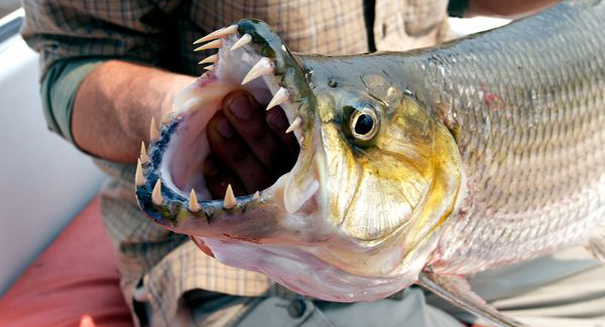
See what scientists believe to be the first ever observation of a freshwater fish attacking birds in flight
We’ve all seen birds prey on fish. They do it all the time, that thing where they dive bomb out of nowhere and then [plunk] they come back up with lunch. It’s also not unreasonable to imagine a very large fish taking advantage of a smaller bird floating on the water’s surface. What is totally, utterly unreasonable, though, is the thought of a fish leaping out of the water to capture a bird mid-flight, but that’s exactly what the African tigerfish does in the video below, according to researchers from South Africa’s North-West University.
This is believed to be the first observed instance of such behavior. Over 15 days, the study observed as many as 20 successful attempts by the tigerfish, noting that they changed their tactics depending on where the birds were located. For prey closer to the surface, the fish would sneak up on it at or near surface level. For nabbing birds mid-flight, the attack originated from deeper water, not unlike how great white sharks stalk and attack seals.
“The African tigerfish is one of the most amazing freshwater species in the world,” said Nico Smit, co-author of the study, according to BBC. “It is a striking fish with beautiful markings on the body, bright red fins and vicious teeth.”
Even more surprising is the fact that the second tactic, where the fish actually leave the water to obtain their meal, was seen to be more successful than the first, more “conventional” strategy. The geometry and physics involved in calculating such a thing are no small feat, especially considering the way water bends light and distorts perception. Given that the fish are so precise, researchers speculate that their technique must have been born out of necessity in the face of a food shortage.
The tigerfish in the study, known as Hydrocynus vittatus, is often regarded as Africa’s freshwater answer to South America’s piranha. They’re most commonly found in the southerly Okavango Delta, and the Zambezi River, and also in the two biggest lakes along the Zambezi, Lake Kariba in Zambia, Zimbabwe, and Cabora Bassa in Mozambique, and finally in the Jozini dam in South Africa. Their larger cousin, Hydrocynus goliath, can grow to a horrifying 110 lbs, and is probably capable of bringing down a helicopter.
Fortunately, it appears that karma is real after all: “This feeding behaviour may increase the risk of the H. vittatus themselves being preyed upon by avian predators such as the African fish eagle Haliaeetus vocifer which are common in the area,” the study adds.
Leave a Reply